Bipedal - Study guides, Class notes & Summaries
Looking for the best study guides, study notes and summaries about Bipedal? On this page you'll find 159 study documents about Bipedal.
Page 2 out of 159 results
Sort by
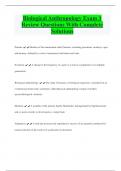
-
Biological Anthropology Exam 1 Review Questions With Complete Solutions
- Exam (elaborations) • 26 pages • 2024
-
- $17.49
- + learn more
Biological Anthropology Exam 1 Review Questions With Complete Solutions Primate ️️Member of the mammalian order Primates, including prosmians, monkeys, apes, and humans, defined by a suite of anatomical and behavioral traits Evolution ️️A change in the frequency of a gene or a trait in a population over multiple generations Biological anthropology ️️The study of humans as biological organisms, considered in an evolutionary framework; sometimes called physical anthropolog...
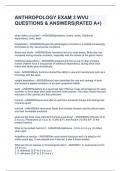
-
ANTHROPOLOGY EXAM 3 WVU QUESTIONS & ANSWERS(RATED A+)
- Exam (elaborations) • 9 pages • 2024
- Available in package deal
-
- $11.99
- + learn more
what makes us human? - ANSWERBipedalism, brains, skulls, Childhood dependency, tools, teeth biopedalism - ANSWERstresses the advantages it provided in a habitat increasingly dominated by dry, savanna-like conditions. Brains and skulls - ANSWEREarly hominins had very small brains, Brain size has increased during hominin evolution, especially with the advent of the genus Homo. Childhood dependency - ANSWERCompared with the young of other primates, human children have a long period of chil...
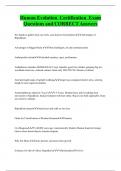
-
Human Evolution Certification Exam Questions and CORRECT Answers
- Exam (elaborations) • 7 pages • 2024
- Available in package deal
-
- $7.99
- + learn more
free hands to gather food, use tools, scan horizon for predatorsAdvantages of Bipedalism: Advantages to Bigger Brain:More Intelligent, art and communication Anthropoids includeincluded monkeys, apes, and humans Ardipithecus ramidus-ARDI4.4-5 mya. bipedal, good tree climber, grasping big toe, wooldand omnivore, reduced canines, brain only 300-350 CM. Mosaic evolution Arm/leg length signs of upright walkinglonger legs compared shorter arms- arm/leg length is more equal in primates
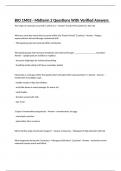
-
BIO 1M03 - Midterm 2 Questions With Verified Answers
- Exam (elaborations) • 25 pages • 2024
-
- $12.99
- + learn more
The origin of mammals occurred in which era? - Answer Triassic Period (252 Ma- 201 Ma) What are some key events that occurred within the Triassic Period? (2 points) - Answer - Pangea supercontinent formed through continental drift. - Therapsida groups had evolved within vertebrates Therapsida groups had increased metabolic rate inferred through: ___________________ (3 points) - Answer - upright posture (relative to reptiles) - muscular diaphragm for enhanced breathing - breathing while ...
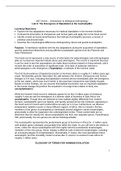
-
ANT 3514C – Introduction to Biological Anthropology Lab 9: The Emergence of Bipedalism & the Australopiths: Research Paper + Q&A
- Exam (elaborations) • 10 pages • 2023
-
- $9.99
- + learn more
ANT 3514C – Introduction to Biological Anthropology Lab 9: The Emergence of Bipedalism & the Australopiths Learning Objectives: • Explore the key adaptations necessary for habitual bipedalism i n the hominin hindlimb • Contrast the kinematics of chimpanzee and human gaits and apply this to the fossil record • Identify cranial and postcranial features that indicate Australopiths possess a mosaic of primitive and derived traits • Describe the morphological differences distinguishing robu...
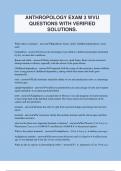
-
ANTHROPOLOGY EXAM 3 WVU QUESTIONS WITH VERIFIED SOLUTIONS.
- Exam (elaborations) • 9 pages • 2024
-
- $11.49
- + learn more
ANTHROPOLOGY EXAM 3 WVU QUESTIONS WITH VERIFIED SOLUTIONS. What makes us human? - answerBipedalism, brains, skulls, Childhood dependency, tools, teeth biopedalism - answerstresses the advantages it provided in a habitat increasingly dominated by dry, savanna-like conditions. Brains and skulls - answerEarly hominins had very small brains, Brain size has increased during hominin evolution, especially with the advent of the genus Homo. Childhood dependency - answerCompared with the young o...
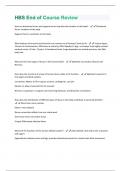
-
HBS End of Course Review Questions And Answers Graded A+
- Exam (elaborations) • 10 pages • 2024
- Available in package deal
-
- $7.99
- + learn more
How can directional terms and regional terms help describe location in the body? - Directional Terms: locations of the body Regional Terms: Landmarks on the body What features of structure and function are common to all humans? (only do 4) - 4 tissue types, 23 pairs of chromosomes, 206 bones at maturity, DNA, Bipedal, (2 legs- not always true) highly evolved cerebral cortex, 24 ribs- 12 pairs, 4 chambered heart, lungs dependent on outside pressure, and little body hair. What are the main ...

-
SOCA 105 Exam 3 Snyder WVU Verified Answers
- Exam (elaborations) • 7 pages • 2024
- Available in package deal
-
- $9.99
- + learn more
SOCA 105 Exam 3 Snyder WVU Verified Answers 2 percent ️What percent different are the homo sapiens from their closet living relative? Acheulian ️lower paleolithic tool tradition associated with h. erectus Alpha Taxonomy ️refers to the discipline of finding, describing, and naming taxa, particularly species Analogy ️a comparison between two things, typically on the basis of their structure and for the purpose of explanation or clarification. anamensis ️4.2-3.9 mya sloping...
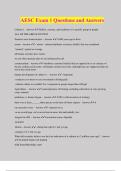
-
AESC Exam 1 Questions and Answers
- Exam (elaborations) • 10 pages • 2024
- Available in package deal
-
- $12.49
- + learn more
AESC Exam 1 Questions and Answers Culture is - Answer ️️ -Beliefs, customs, and traditions of a specific group of people. ALL OF THE ABOVE ON TEST Potatoes were domesticated- - Answer ️️ -8,000 years ago in Peru norms - Answer ️️ -. norms - cultural attributes (customs, beliefs) that are considered "normal", typical or average all human societies have norms we are often unaware that we are influenced by all counterculture - Answer ️️ -•attributes customs/ beliefs) tha...

-
Anthropology Final-ANT 100 Lacquament Exam Questions and Answers 100% Pass
- Exam (elaborations) • 14 pages • 2024
- Available in package deal
-
- $12.49
- + learn more
Anthropology Final-ANT 100 Lacquament Exam Questions and Answers 100% Pass _ consists of traditions and customs, transmitted through learning, that form and guide the beliefs and behavior of a group of people. - Answer- Culture Cultural Anthropology - Answer- Study of human society and culture Archaeology - Answer- Study of human behavior through material remains Biological Anthropology - Answer- Study of human biological variation through time and as it exists today linguistics - Answer...

Study stress? For sellers on Stuvia, these are actually golden times. KA-CHING! Earn from your study resources too and start uploading now. Discover all about earning on Stuvia


